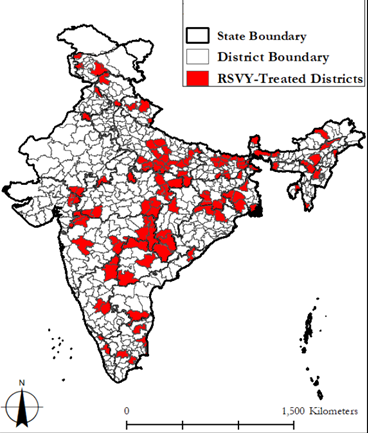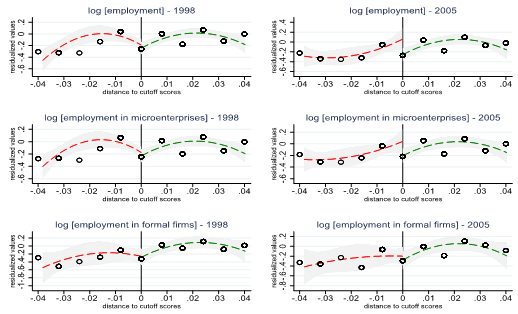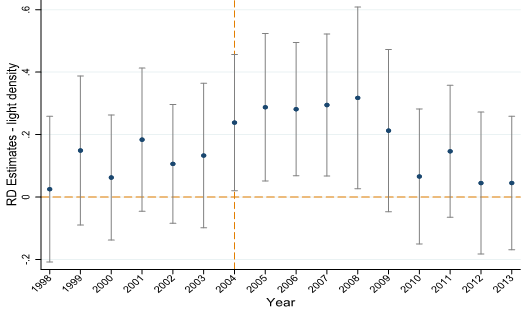Estimating the effects of physical infrastructure investments on economic growth has remained challenging, especially in rural settings. This article studies the effects of a rural infrastructure grants programme launched to facilitate physical infrastructure development in the most economically backward districts in India. It provides evidence on the effectiveness of the programme, especially on microenterprises, with stronger impacts in electricity and road-intensive industries, and in villages that had paved roads and electricity prior to the programme.
Physical infrastructure investments are important determinants of economic growth (World Bank, 1994), and are one of the main United Nations Sustainable Development Goals (SDGs). However, estimating the causal effects of infrastructure on the local economy is often very challenging. This is because these investments are either directed to fast-growing regions or to economically lagging regions, making comparisons between places that received infrastructure and those that did not infeasible. Among rural, remote, and low-income households, where the demand (and willingness-to-pay) for these services is low, studying the effects of infrastructure is especially complicated. A number of recent papers (rural roads – Asher and Novosad,forthcoming; rural electrification – Aklin et al. 2017, Burlig and Preonas 2016, Lee, Miguel and Wolfram, forthcoming) have found no broad-based effects of rural infrastructure investments on households. Rural firms however, may respond very differently than rural households, because infrastructure is a production input and also a prerequisite for the supply chain. It is thus important to analyse the response of firms in order to understand the effectiveness of rural infrastructure programmes.
In recent research (Chaurey and Le 2019), we study the effects of a rural infrastructure grants programme, Rashtriya Sam Vikas Yojana (RSVY), launched by the Government of India in 2003-04, that were extended to 115 districts based on ‘backwardness’ scores. RSVY was launched with the main goal of facilitating physical infrastructure development in the most economically ‘backward’ districts in India. Under RSVY, each eligible district was entitled to receive Rs. 450 million (US$10 million (2010 exchange rates)), over the course of three years, to address ‘critical gaps’ in physical and social infrastructure. According to the guidelines, the funds were to be utilised to improve or make complementary investments to existing infrastructure rather than on completely new projects. Therefore, RSVY could be considered as an infrastructure-enhancing grant. For example, RSVY funds could be spent on widening and strengthening of roads, to build small bridges, to build vital road links to connect to the marketplace, and for strengthening the rural electricity transmission and distribution infrastructure. There was flexibility to spend the RSVY funds on multiple small infrastructure-related projects. This flexibility in the use of funds made RSVY different than other programmes that often focus on building a specific infrastructural facility such as new roads and highways, or dams, or electricity grids.
RSVY had a transparent allocation procedure that was explicitly documented by the Government of India. The eligibility of districts under RSVY, was based on a two-step process. In the first step, the central government determined the number of treatment districts that would be assigned to each of the 17 major Indian states. The quotas were worked out on the basis of state-level prevalence of poverty. In the second step, each state government, in accordance with the assigned quota, chose the specific districts to allocate the RSVY grants. The selection was based on an existing development ranking known as the ‘Backwardness Index’. This ranking index was public information, and a composite level of districts’ economic underdevelopment was constructed from three historical parameters with equal weights: (i) value of output per agricultural worker (1990-1993); (ii) agriculture wage rate (1996-1997); and (iii) districts’ percentage of low-caste populations — Scheduled Castes/Scheduled Tribes (1991).
Figure 1. Districts that received RSVY funds
We reconstruct the Backwardness Index scores for each district and use the distance to the score of the cut-off district in each state as the running variable in a Regression Discontinuity Design (RD) framework. Essentially, we compare districts to the left of the cut-off (‘treated’ districts) to those to the right of the cut-off (‘control’ districts) in a narrow bandwidth. We combine multiple datasets covering the entire firm-size distribution (Economic Censuses, Annual Survey of Industries, National Sample Survey (NSS) manufacturing enterprises schedules), household surveys (National Sample Survey employment and unemployment schedules), as well as data on nighttime lights to analyse the effects of the programme, as well as the mechanisms driving these effects.
Main results
We find a number of results on the effectiveness of RSVY in the short run. First, we find that overall village employment in RSVY districts increased by 11% relative to control districts. This was driven entirely by village employment in microenterprises, with no effect on employment in formal firms. In Figure 2, the left-hand panel shows village-level employment before RSVY (in 1998) and the right-hand panel shows village-level employment after RSVY (in 2005).
Figure 2. Effects of RSVY on village-level employment
Next, we analyse firm-level regressions separately for microenterprises and formal firms. We find, on average, a 5-13% increase in microenterprise employment, corresponding to an increase of 0.2-0.35 workers per firm.
Figure 3. Effects of RSVY on firm-level (for microenterprises) employment

Note: The left-hand panel shows the effects before RSVY and the right-hand side panel shows the effects after RSVY.
Source: NSS manufacturing enterprise schedules.
However, formal firms did not experience an increase in employment. This is not surprising given that RSVY was a rural infrastructure programme and most formal firms in India locate in or near urban areas, and 36.5% of these formal firms own a generator.
On the extensive margin, we find an increase in the number of firms in villages in RSVY districts, again entirely driven by an increase in the number of microenterprises. Thus, overall, we find that RSVY led to the growth of microenterprises.
Next, we look at the effect of RSVY on individual and household outcomes, and find increases in individual wages (10-13%), and number of days worked (3%), which corroborate our village and firm-level results. We also look at whether there was a change in the probability of being unemployed, or a change in the probability of being a migrant, and do not find any statistically significant differences. However, we find a decline in the probability of being an agricultural wage worker by 3-5% in the treated districts, but no changes for agricultural land-owners.
Channels
It is important to understand the possible channels through which the RSVY affected the performance of small firms. First, we find an increase in the overall infrastructure development following RSVY in the treated districts, as measured by nighttime light intensity. We find these effects for all years in which RSVY was in place, but the effects dissipate starting 2008-09. This is because the Government of India subsumed RSVY by introducing the Backward Regions Grant Fund in 2007-08, and expanded the coverage to 250 backward districts. This expansion to previously uncovered districts, makes it hard to study the longer-run effects of RSVY.
Figure 4. Effects of RSVY on taluk-level nighttime light intensity
Next, we find that there was a significant reduction in the probability of experiencing a power cut and problems with access to raw materials for microenterprises. We interpret these results as suggestive evidence for improvements in rural electrification and connectivity in RSVY districts. To provide additional supporting evidence for these two channels, we focus on firms in electricity and road-intensive industries. The reductions in probability of power cuts and problems with access to raw materials are concentrated in the most electricity and road-intensive industries respectively. We also find that firms in the most electricity and road-intensive industries had the largest increases in employment.
Finally, the purpose of RSVY funds was to fill critical infrastructure gaps rather than on providing roads to unconnected areas or electricity grids in unelectrified areas. As such, the effects of this infrastructure-enhancing policy should be larger in villages where paved roads and electricity already existed before RSVY compared to villages without paved roads and electricity. We find evidence consistent with this claim. We show that after the implementation of RSVY, employment in microenterprises as well as number of microenterprises increased in villages that had both paved roads and electricity prior to the policy, and no effects in villages without paved roads and electricity.
Conclusion
The results of our paper inform policymakers on the effectiveness of rural infrastructure programs in developing countries. Our research also underscores the importance of focusing on microenterprises, that account for a substantial share of employment in the Indian context. A limitation of our analysis is that we are only able to look at the short-term effects of infrastructure grants. Especially, for developing countries with large infrastructure gaps, studying the long-run effects of infrastructure investments is critical.
Further Reading
- Aklin, Michaël, Patrick Bayer, SP Harish and Johannes Urpelainen (2017), “Does Basic Energy Access Generate Socio-Economic Benefits? A Field Experiment with Off-Grid Solar Power in India”, Science Advances, 3: e1602153.
- Asher, Sam and Paul Novosad (forthcoming), “Rural Roads and Structural Transformation”, American Economic Review.
- Burlig, F and L Preonas (2016), ‘Out of the Darkness and Into the Light? Development Effects of Rural Electrification’, Working Paper.
- Chaurey, R and D Le (2019), ‘Rural Infrastructure Development and Economic Activity’, Working Paper. Available here.
- Lee, Kenneth, Edward Miguel and Catherine Wolfram (forthcoming), “Experimental Evidence on the Economics of Rural Electrification”, Journal of Political Economy.
- World Bank (1994), ‘World Development Report 1994: Infrastructure for Development’, Technical Report, World Bank.




 18 March, 2020
18 March, 2020 








By: Ravikumarsharma 26 July, 2020
Good